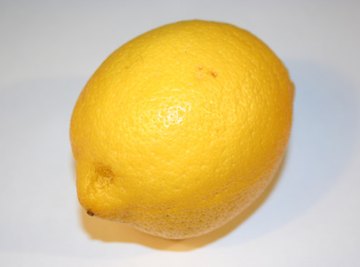
Creating fruit battery science projects is a great way for children to learn about the way electricity works. A popular concept, these experiments are inexpensive and explore the way in which the fruit's acid combine with electrodes such as zinc and copper to produce an electric current. While the current generated by a single piece of fruit is quite weak, variations of these science projects are available that produce more substantial amounts of power.
Basic Fruit Battery
A basic fruit battery can be made using a fresh lemon. While other fruits can be used, the high acidity of citrus fruits makes them the best for these experiments. Roll the lemon gently on the table to activate the juices, being careful not to break the skin. Cut two small slices, 1/2 inch apart, in the lemon and insert a clean copper penny into one slot and a dime into the other so that the metals do not touch. For this step, you can also use zinc and copper strips. The acid in the lemon reacts with the positive and negative electric charges of the coins. Touch your tongue to the dime and penny at the same time and you should feel a tingling sensation.
Fruit Powered Clock
While a single lemon battery produces less than one volt of electricity, connecting two lemon batteries with a copper wire can power a small digital clock. Roll the lemons to activate the juices before making two small cuts approximately an inch apart in each one. Take three lengths of copper wire and attach a penny to one, a large paperclip to another and a penny and a paperclip to either end of the last piece. Connect the two lemons using the copper wire attached to the paperclip and the penny. Insert the copper wires with the opposite attachments into the remaining holes; each lemon should have one penny and one paper-clip. Power up the digital clock by attaching the free copper wires to its positive and negative terminals.
Fruit Powered Light
Connect a series of lemons together in the same manner described in Section 2 to power a flashlight bulb or other small light bulb. Experiment with the number of lemons, or other fruits, you need to power light bulbs of different sizes. You can also connect lemons together using copper pennies, galvanized, or zinc-covered, nails and alligator clips to power an LED light. An LED, or a Light Emitting Diode, is useful for this kind of science project because it is designed to work at low currents and voltages.
Additional Ideas
While fruit batteries have been proven effective, experiment with the positioning of the wires and other aspects of your project if creating fruit powered light does not seem to be working on your first try. Consider using a device such as a micro ammeter or volt meter, which can be found at electronics stores, to measure the voltage of your fruit batteries. Take readings of the voltage for single-lemon batteries and compare that data to the voltage generated by batteries using multiple pieces of fruit. Also consider creating fruit batteries from several different fruits, such as lemons, apples and potatoes, and comparing the effectiveness and voltage generated by each one.
